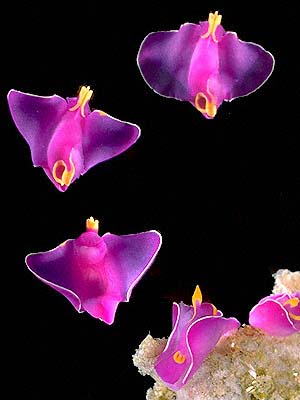
Swimming in opisthobranchs
PHOTO
Sagaminopteron ornatum - a composite photo showing swimming behaviour. Photo: Bill Rudman
Swimming behaviour has evolved a number of times in the opisthobranchs. In some it fulfils its normal role as a means of locomotion, but in many cases it appears to have evolved as an escape mechanism. If you go to the Forum's SEARCH PAGE and type swimming you will find many examples.
NOTE: If some one would like to prepare a review for the Forum on swimming it would be very welcome.
References:
I have listed here a bibliography of relevant papers. They are either descriptions of swimming in a particular species, or general reviews. I have added a few recent review papers on behavioural & physiological aspects of swimming as a way into the growing literature in that area.
- Anderson, R. (1988) Swimming nudibranchs. Shells & Sea Life, 20(1): 9-10.
- Arakawa, K.Y. (1962) Miscellaneous Notes on Mollusca (3). Venus, The Japanese Journal of Malacology, 22(2): 173-175.
- Bebbington, A. & Hughes, G.M. (1973) Locomotion in Aplysia (Gastropoda, Opisthobranchia). Proceedings of the Malacological Society of London, 40: 399-405.
- Davenport, J. & Bebbington, A. (1990) Observations on the swimming and buoyancy of some thecosomatous pteropod gastropods. J. Moll. Stud. 56: 487-497.
- Edmunds, M. 1968c. On the swimming and defensive response of Hexabranchus marginatus (Mollusca, Nudibranchia). Journal of the Linnean Society (Zoology), 47(313): 425-429.
- Farmer, W. M. (1970) Swimming gastropods (Opisthobranchia and Prosobranchia). The Veliger 13(1): 73-89.
- Haefelfinger, H-R. & Kress, A. (1967) Der Schwimmvorgang bei Gasteropteron rubrum (Rafinesque 1814) (Gastropoda, Opisthobranchiata). Revue Suisse de Zoologie, 74: 547-554.
- Hamilton, P.V., & Russell, B.J. (1982) Celestial orientation by surface-swimming Aplysia brasiliana Rang (Mollusca: Gastropoda). J. Exp. Mar. Biol. Ecol. 56: 145-152
- Hamilton, P. V. 1985. Migratory molluscs, with emphasis on swimming and orientation in the sea hare, Aplysia, pp. 212-226. In: M. A. Rankin, D. Checkley, J. Cullen, C. Kitting, & P. Thomas (Eds.), Migration: mechanisms and adaptive significance. Contributions in Marine Science (Marine Science Institute, University of Texas at Austin, Port Aransas, Texas) vol. 27, supplement.
- Harbison, G.R. (1992) Observations on the swimming and buoyancy of Cymbulia peroni (Gastropoda: Thecosomata) made from a submersible. Journal of the Marine Biological Association, United Kingdom, 72: 435-446.
- Johnson, S. 1984. A new Indo-West Pacific species of the dendronotacean nudibranch Bornella (Mollusca: Opisthobranchia) with anguilliform swimming behavior. Micronesica, 19(1/2): 17-26.
- Martin, R. (1966) On the swimming behaviour and biology of Notarchus punctatus Philippi (Gastropoda: Opisthobranchia). Pubblicazioni Stazione Zoologica di Napoli, 35: 61-75.
- Morton, J.E. (1954) The biology of Limacina retroversa. Journal of the Marine Biological Association, United Kingdom, 33: 297-312.
- Morton, J.E. (1958) Observations on the gymnosomatous pteropod Clione limacina (Phipps). Journal of the Marine Biological Association, United Kingdom, 37: 287-297.
- Satterlie, R. A. 2001. Swimming in opisthobranch mollusks: Contributions to control of motor behavior: Introduction to the symposium. American Zoologist, 41(4): 939-942.
- Thompson, S. H. (1999) Central pattern generator for swimming in Melibe. American Zoologist, 39(5): 109A.
- Thompson, T.E., & Slinn, D.J. (1959) On the biology of the opisthobranch Pleurobranchus membranaceus. Journal of the Marine Biological Association, United Kingdom, 38: 507-524.
- Thompson, T.E. (1972) Observations on Hexabranchus from the Australian Great Barrier Reef (Gastropoda: Opisthobranchia). The Veliger, 15(1): 1-5.
- Watson, W. H., K. A. Lawrence, & J. M. Newcomb. 2001. Neuroethology of Melibe leonina swimming behavior. American Zoologist, 41(4): 1026-1035.
- Willows, A. O. D. (2001) Costs and benefits of opisthobranch swimming and neurobehavioral mechanisms. American Zoologist, 41(4): 943-951.
Rudman, W.B., 2003 (December 10) Swimming in opisthobranchs. [In] Sea Slug Forum. Australian Museum, Sydney. Available from http://www.seaslugforum.net/find/swimming
Related messages
Dorsal/ventral swimming in nudibranchs
December 11, 2003
From: Paul Katz
Does anyone know if there are any nudibranchs besides Tritonia species that swim with dorsal/ventral body flexions? Many species swim with lateral body flexions. The description of swimming by Plocamopherus ceylonicus sounds like it might be a dorsal/ventral swimmer because it flattens in the doral/ventral axis. Can someone comment on that? The Notaspid, Pleurobranchaea californica also swims dorsal/ventrally. Are there others?
Also, does anyone know of any other interesting swimming movements in nudibranchs that differ from just lateral flexions. Certainly, Hexabranchus sanguineus seems to have undulations that are more complex than lateral flexions. Could they be a combination of lateral and dorsal/ventral flexions? Also Bornella anguilla has "eel-like" movements that could be more complex than simple lateral flexions.
Thanks,
Paul Katz.
pkatz@gsu.edu
Katz, P., 2003 (Dec 11) Dorsal/ventral swimming in nudibranchs. [Message in] Sea Slug Forum. Australian Museum, Sydney. Available from http://www.seaslugforum.net/find/11673Dear Paul,
There is quite a literature on the topic so I have prepared a Fact Sheet and bibliography which should get you into the topic. I guess Rule 1 is that there is no general rule. Some tritoniids exhibit dorso-ventral flexion, but there are others which show lateral flexion. The eel-like flexion of Bornella anguilla seems to be a development of the simple lateral flexion found in other species of the genus.
If you move outside the nudibranchs there are many wonderful adaptations for swimming that have evolved. Are you planning to do some research in the area?
Best wishes
Bill Rudman
NOTE: If there is anyone who would like to prepare a review on swimming for the Forum? It would be very welcome. Contact me for some guidelines.
Rudman, W.B., 2003 (Dec 11). Comment on Dorsal/ventral swimming in nudibranchs by Paul Katz. [Message in] Sea Slug Forum. Australian Museum, Sydney. Available from http://www.seaslugforum.net/find/11673